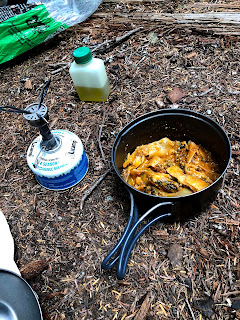Here's how I did it. Cook any lasagne recipe that you have (sometimes the boxes have a recipe on the side), and after it is finished, let it cool it down. Might as well have a slice to eat while it is warm - nothing like a freshly made lasagna. Anyway, put it in the refrigerator, and let the entire lasagna congeal. Slice it in 3/4 - 1" slices after it is cold, and then put it in a food dehydrator. The dehydration process will take about 18-20 hours, which is longer than other dehydrating other foods like refried beans or even bananas.
Now comes time to package your lasagna. I have one of those Seal-A-Meal devices, which I bought at an Albertson's in San Francisco. It works, but they are noisy, and foods that get jaggedy and sharp can puncture the plastic wrap. Yes, when dehydrating lasagne, it is important to package it carefully, so that the dried pasta does not puncture the seal. I've found that it is sometimes best to wrap the lasagne in a layer of regular Saran Wrap to soften the jagged edges from puncturing the seal-a-meal packaging. My friend, Stormy, told me that she and her partner ran their dehydrated meals through a food processor and blender to prevent punctures in their seal-a-meal wrappings. She ate what she described as "power mush,' saying that they had all the flavor, but the consistency of mush.
On trail, it is a good idea to pull out the lasagne at the beginning of the day, and add just a slight amount of water. Allow the lasagne to absorb the water, and kind of let it stew on the outside of your pack all day. Be sure the lasagna is not going to leak out its water, and furthermore be careful with how it is situated in your pack - trust me, you don't want lasagna water running all over your pack!
When it is time to cook, add more water, but not a lot more. I know that's vague, but I don't bring measuring cups with me in the backcountry. Still, rehydrating your lasagna is just going to best left to your own judgment. I personally don't like to eat my lasagna as a stew, so I carefully monitor how much water I put in my cook pot. Only a little bit of fuel (good reason why it is ultralight!) should be used to heat up the lasagna. Stir briskly in the pot, so it does not burn the bottom of your pot, add a bit more water if needed, and enjoy!
When it is time to cook, add more water, but not a lot more. I know that's vague, but I don't bring measuring cups with me in the backcountry. Still, rehydrating your lasagna is just going to best left to your own judgment. I personally don't like to eat my lasagna as a stew, so I carefully monitor how much water I put in my cook pot. Only a little bit of fuel (good reason why it is ultralight!) should be used to heat up the lasagna. Stir briskly in the pot, so it does not burn the bottom of your pot, add a bit more water if needed, and enjoy!
 |
| Cooking Lasagna |
The lasagna will not have the exact same consistency as if you pulled it out of the oven, but it's close. Just a reminder, it's freaking lasagne on the trail! Enjoy it while everyone else eats their Knorr with tuna or an over-priced Mountain House meal in a heavy-duty plastic packaging. Treat yourself well out there. Eat right, and happy hiking!
 |
| Happy Hiker Eating Lasagna |


No comments:
Post a Comment